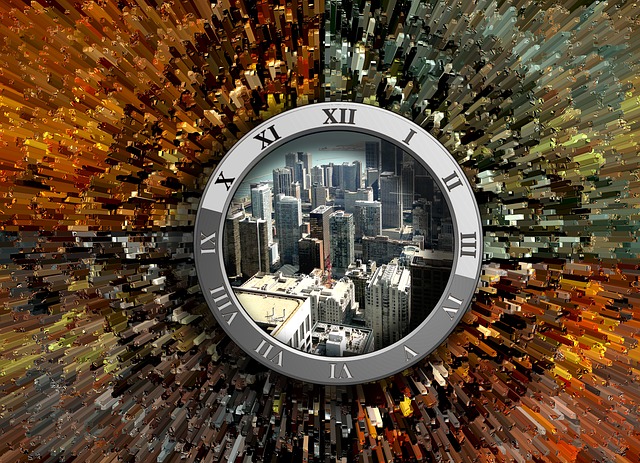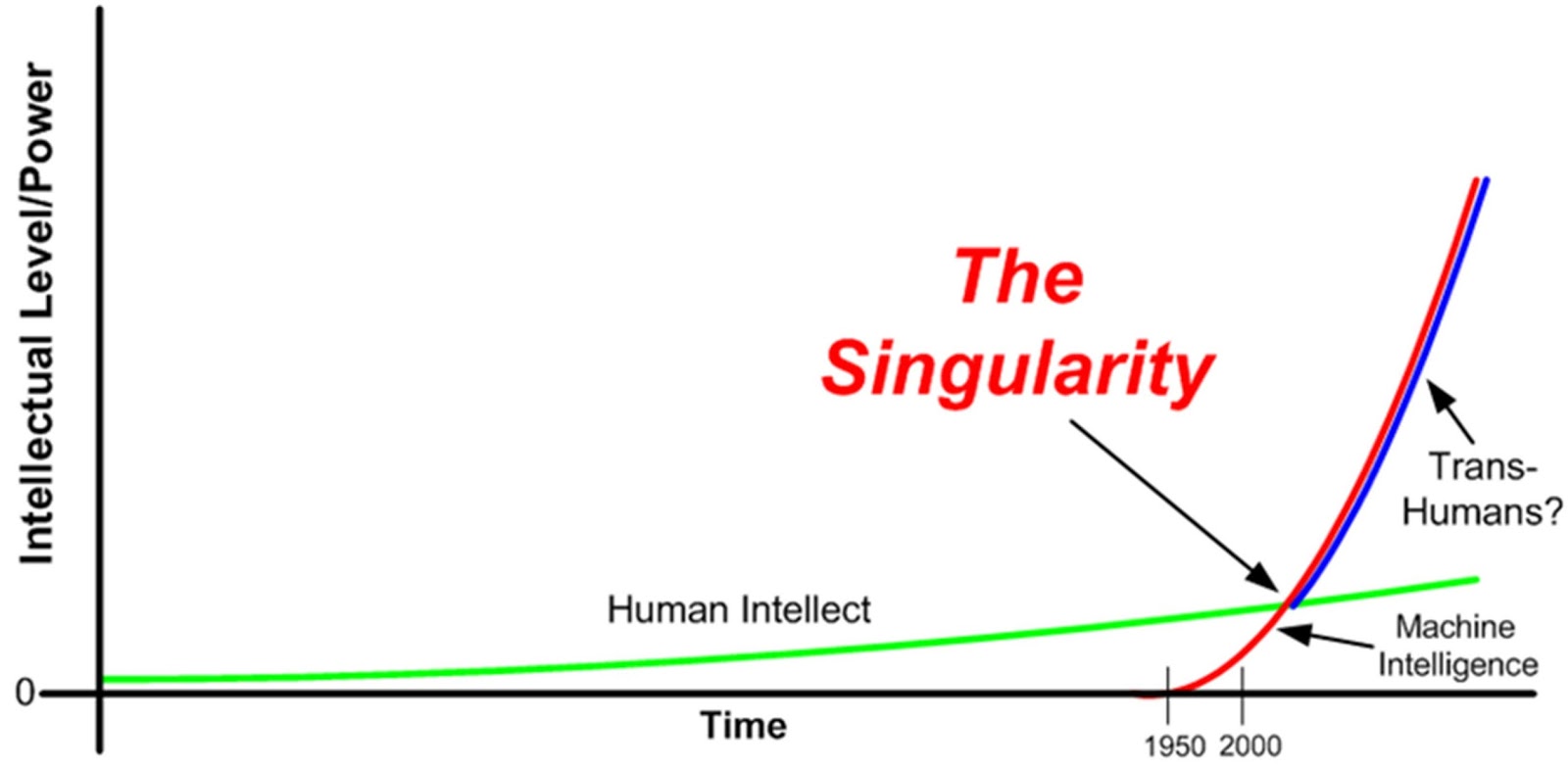Man and Superman: Life Near An Approaching Technology Singularity

By Guest Author Frank H. Levinson
Ray Kurzweil began writing more than 25 years ago about the possibility of a technology singularity occurring sometime in the late 20th century. He defines “Singularity” as “a future period during which the pace of technological change will be so rapid, its impact so deep, that human life will be irreversibly transformed.”
And in another place he continues,
“The Singularity is an era in which our own intelligence will become increasingly non-biological and trillions of times more powerful than it is today, allowing us to transcend our biological limitations and amplify our creativity.”
And in terms of a graph, he depicts it like this:

Today, we are perhaps 50% closer to the actual event than we were when he began publishing this observation. Let’s look around for some early evidence of this singularity for ourselves.
The Frequency and Impact of Science Revolutions
Yuval Noah Harari argues in Sapiens: A Brief History of Humankind that the first major scientific/technology revolution was the invention of modern agriculture. With this invention, humans learned to domesticate plants and animals. This allowed humans/sapiens to transition from nomadic hunting and gathering tribes to having the ability to build communities and feed themselves by growing their own food while staying in one place. This started around 11,000 BCE and humans’ early mastery of agriculture was fully diffused globally over the next 2000-4000 years. As nomads, humans depended on nature to produce their food randomly. They had to move about to find it because when they’d exhaust resources in an area, they would need to let nature regenerate that area before they could return. In a way, before agriculture, humans were just another migratory animal species. Farming allowed humans to control nature in a fixed area to their benefit. Staying at one place allowed them to build more substantial structures not just in physical terms of where they lived but also in abstract terms of how they organized their societies. [~10,000 BCE, time span 2000 years]
Agriculture also allowed much larger numbers of humans (sapiens) to live in a single fixed place and therefore for a cooperative social culture to evolve.
Up to this time, we had two forms of reality – objective and subjective.
“Objective reality” comprises those thoughts or facts that exist independently of our minds. For example, 2 + 2 = 4 is a statement of objective reality. It is true and verifiable by means of observation and proof.
“Subjective reality” comprises those thoughts that are true for an individual but are not verifiable by another. For example, the statement “I have a headache” is not generally or easily provable, but it is nevertheless true for the person with the headache.
Harari notes in his writings that there is a third type of reality that he calls “intersubjective realites” (ISRs). ISRs are those ideas or concepts that a group of people can agree to hold and use daily as true but which in and of themselves are not objectively true. For example, one ISR is the value we have for a $20 bill. Objectively, it is just a fancy printed piece of paper; its value is not intrinsically much more than the paper. BUT … a group or people (like the citizens of the USA) can agree together to treat it as if it has much higher value and exchange this special paper for food, or fuel, or clothing all of which DO have substantive value.
Harari’s key argument is that Sapiens have a unique ability, distinguished from all other species, to cooperatively engage in defining and sharing ISRs, in which today hundreds to millions of beings hold and agree upon some belief that can drive and organize behavior. This gives our species our special status in nature. Through ISRs we can create religions, paper money, democracy, capitalism, and human “rights” that groups of us can believe in – all things that exist only because we agree they do – and thereby create a society that bonds people together to advance one ISR over another. Sapiens are story telling creatures and our stories give us power to work in large groups and to develop and diffuse complex ideas and social structures.
While domestication of food sources, in a sense, gave humans the potential to develop this special capability, on its own, it is not sufficient to explain the vast power that we have today behind our social shared beliefs. We need more scientific revolutions, and this will be the subject of our next installment.
This segment is a part in the series : Man and Superman
. Human History Bifurcates
. Two Distinct Species
. What CAN Be Controlled?
. Rationalizing Populations
. How Long Does Democracy Survive?
. The Environmental Time Bomb
. Role of Religion
. Will There Be Revolution?
. Is There an Action Item?
. A Case for Human HappinessMore »»
. Life Near An Approaching Technology Singularity
. Modern Science Revolutions
. Impact of the Science Revolutions
. Intersubjective Realities
. Dealing with Singularity-Based Technology Acceleration
. The Future of Work
. Can Displaced Blue Collar Workers Become Doctors?
. Future of Education
. Augmentation of the Human Brain
. Human History Bifurcates - Talk at RKM Kolkata (Video)
. India's Prospects in the Age of AI (Part 1)
. India's Prospects in the Age of AI (Part 2)
. India's Prospects in the Age of AI (Part 3)
. India's Prospects in the Age of AI (Part 4)
. India's Prospects in the Age of AI (Part 5)
. India's Prospects in the Age of AI (Part 6)
. India's Prospects in the Age of AI (Part 7)
. India's Prospects in the Age of AI (Part 8)
. India's Prospects in the Age of AI (Part 9)
. India's Prospects in the Age of AI (Part 10)
Featured Videos
Can 1M/1M Help Me Raise Money?
How Does 1M/1M Democratize Entrepreneurship Education?
How Does 1M/1M Democratize Management Consulting?
When Is The Right Time To Join 1M/1M?
Can 1M/1M Help Me With Business Development?
Can 1M/1M Help Me With Market Sizing?
Can 1M/1M Help Me Validate My Product?
Will I Have Private 1-on-1 Sessions In 1M/1M?
How Does 1M/1M Help Entrepreneurs Connect With Silicon Valley?
Mentoring or Consulting?
Why Does 1M/1M Charge $1000 a Year?
Why Does 1M/1M Partner With Local Organizations?
Why Don\’t Mentoring Networks Work?
Why Is It Important To Study With 1M/1M Now?
Dan Stewart Story
Vikrant Mathur Story
